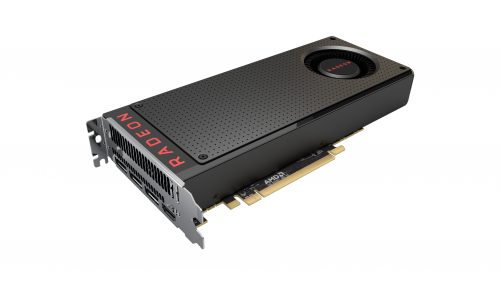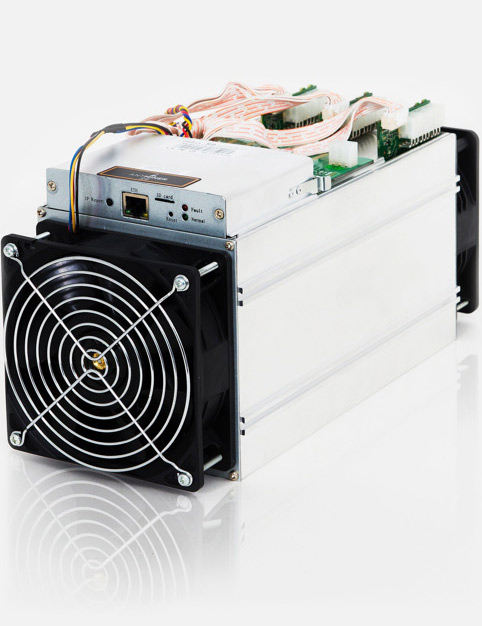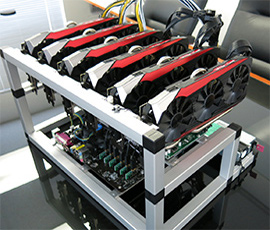Over the last month, high-performance graphics cards have disappeared from retailer stock, selling out immediately as they appear. Although AMD’s new RX 580 offers decent graphics performance for the money, gamers aren’t driving this demand. Instead, it’s all about cryptocurrency mining, with Ethereum leading the way. It’s time for AMD to get in on this game, with special mining-edition cards and drivers tuned for GPU computing rather than video games.

Mining Bitcoins
By now, pretty much everyone on earth knows about Bitcoin, the decentralized “cryptocurrency” that is disrupting the financial market. After a tentative start and tumultuous first few years, Bitcoin has emerged in 2017 as a legitimate contender for international money transfer. It is especially useful in markets like China and Russia, where governments would like to control remittances and citizens have overseas money to move. Although a large volume of Bitcoin transactions remain speculative, it is carving out a useful niche.
Bitcoin proved not only that a virtual currency could work, it also created a new industry: Cryptocurrency mining. Each Bitcoin transaction is stored in a distributed ledger, with a vast network of computers constantly working to verify these transactions mathematically. The Bitcoin software cleverly rewards all this hard work with free ‘coins, a process which has come to be known as mining.

The incredible increase in the value of Bitcoins has created a cottage industry for Bitcoin mining. The SHA-256 function used by Bitcoin for proof-of-work is adaptable to special-purpose hardware, and today it is impractical to mine with anything other than the specialty ASICs developed by companies like Bitmain. Today’s top-dog AntMiner S9 generates about $15 per day while guzzling 1,370 Watts to power the 189 BM1387 ASICs inside. This is literally thousands of times faster than any CPU or GPU on a per-Watt basis.
These ASICs have gotten so good that Bitcoin mining has followed cheap energy to the remote reaches of China, with hydro- and wind-power utilities filling rooms with AntMiner rigs. This explosion of mining power has concentrated the Bitcoin network and made it impractical to mine elsewhere.
Altcoin, not Bitcoin
As Bitcoin mining becomes increasingly concentrated, a large number of alternative digital “coins” have recently appeared to fill the vacuum. Some have proven to be scams or simple “me-too” copies, but a few stand out as legitimate. Most of these “altcoins” have adopted proof of work hashes (namely Ethash and Equihash) that are less likely to be conquered by specialty ASICs. Indeed, most of these hashes are most efficient using the GPU’s in conventional graphics cards.
Ethereum is the class act of the altcoin world, bringing novel innovations like smart contracts to the table. Ethereum was designed to use the massive computing power of mining for more practical purposes, though non-financial applications have not yet materialized. Ethereum has even become the basis for the “initial coin offerings” (ICO’s) of other altcoins. All this has made Ethereum a darling for miners, driving the relative price ever upwards.
Another very interesting altcoin is Zcash, the product of a cadre of smart industry veterans. Although still in its infancy, ZCash boasts the best privacy protections in the altcoin universe, with truly untraceable transactions. The value of ZCash has risen steadily since its October, 2016 introduction, and it has been adopted by many of the more-respectable elements of the cryptocurrency world.
Altcoin Mining Rigs
While Bitcoin mining has been concentrated in ASIC farms in China, Altcoin mining remains profitable with attainable hardware. Anyone with a modern graphics card can generate a few dollars a day, and even ordinary CPU’s remain slightly profitable. If it wasn’t for the dizzying assortment of “coins” and forbidding jargon, altcoin mining would likely be eclipsing Bitcoin in terms of public awareness.
Still, altcoin mining is on the rise. Projects like ethOS make it easier than ever to set up a mining “rig”, and the learning curve isn’t so steep that a technical-minded person can’t catch on. Another boon for casual miners is the creation of mining pools, which combine the efforts of many miners and share the resulting coins for a more predictable and attainable payout. Profits can be collected in an easy-to-use wallet or automatically converted to Bitcoin or even dollars.

A $200 AMD RX-580 graphics card will generate about $6 per day in Ethereum (ETH) or $3.50 per day in ZCash (ZEC). At that rate, payback is only a month or two away! Pretty much any PC will support one or more of these graphics cards, humming away in a basement or garage and generating quite a bit more than the cost of electricity.
Once it becomes clear how easy and rewarding it is to mine Ethereum, Zcash, or another altcoin, one will be tempted to build a “real” mining rig. PCI Express risers allow a half-dozen graphics cards to be attached to a single motherboard, and a thousand watts of electricity isn’t out of the question for a home or small business. And this rig would generate about $35 per day in profit.
Where Have All the GPU’s Gone?
If you’ve read this far, perhaps you can see the reason for the spectacular sales of consumer graphics cards lately. Although gaming remains widely popular, most games don’t need the horsepower of today’s midrange ($200+) graphics cards. Yet AMD’s newly-refreshed RX-580 (which sells for $200-$300) is out of stock just about everywhere. Altcoin mining rigs must be springing up all over the world!
Interestingly, although Nvidia’s Tesla cards are incredible powerful, they lag behind AMD’s Polaris in terms of Ethash performance per Watt and cost much more to boot. Nvidia 10×0 cards are still occasionally found on retail shelves, while AMD cards are gone.
Graphics card manufacturers should respond to this situation by creating special mining-oriented cards. Altcoin miners want better cooling and faster RAM, not the turbo core speeds, bandwidth, and plentiful ports featured on today’s cards. I suspect this new market will soon be attacked by AMD and its OEM’s, with specialty 1x PCIe cards that might not even have a single monitor connector! Perhaps some of the PC OEM’s will respond too, rolling out multi-GPU mining rigs.
Stephen’s Stance
General-purpose GPU computing has been on the rise for years, from OpenCL and CUDA to machine learning and self-driving cars. But cryptocurrency mining has exploded in 2017, draining the market of AMD’s latest graphics cards as mining rigs pop up from basements to warehouses all over the world. The strength of Bitcoin in international finance suggests that Ethereum, Zcash, and others “altcoins” will find their own niches. We are seeing the emergence of a new computing category.
my gtx 1070 is in the service center for replacement and they don’t have the stock go replace it for me. refunding wouldn’t cut since now prices are higher than before. so I can’t buy another gtx 1070 for the same price. what am I to to do now. I’m on my backup gt740 who I use to desktop use.
New original Antminer S9 14TH/s + PSU 1600W APW3++ Bitcoin ASIC Miner cost 1200usd
New 2018 Hot sale Baikal Giant B with PSU Dash Coin Miner cost 6000USD
Antminer D3 cost $1,500 each unit including PSU and delivery to your home address.
Baikal giant 10 4000usd each unit including PSU and delivery to your home address.
Antminer A3 840 3500USDeach unit including PSU and delivery to your home address.
Antminer L3+ cost $1,300 each unit including PSU and delivery to your home address.
Delivery takes just 2-3 daysto your home doorstep through FedEx,Ups or Dhl shipping courier services.
We accept payment through Western Union or Money Gram Transfer and also Bank transfer and BTC .
IF YOU ARE READY TO PLACE ORDER AND FOR QUICK REPONSE CONTACT US HERE:
Whatsapp CHAT or Call : +19842085304
Email: [email protected]
Ignoring the economics of it, this seems ridiculous. Literally a machine that takes in power and repeats checks performed prior by another. Entropy at it’s best.